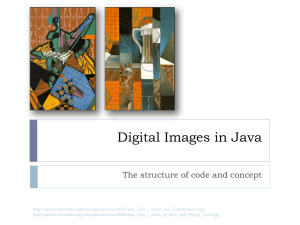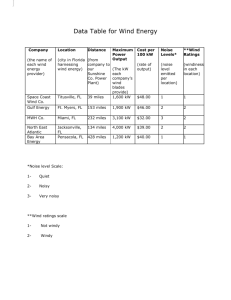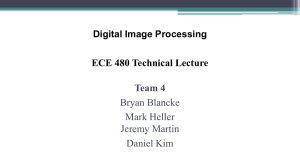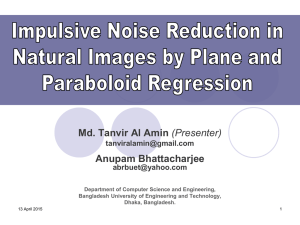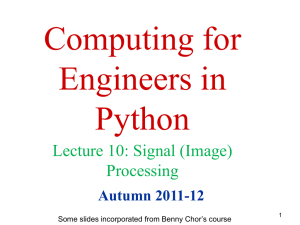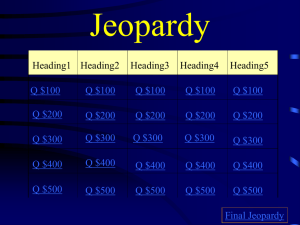Corrupted image segment Restored image segment
advertisement
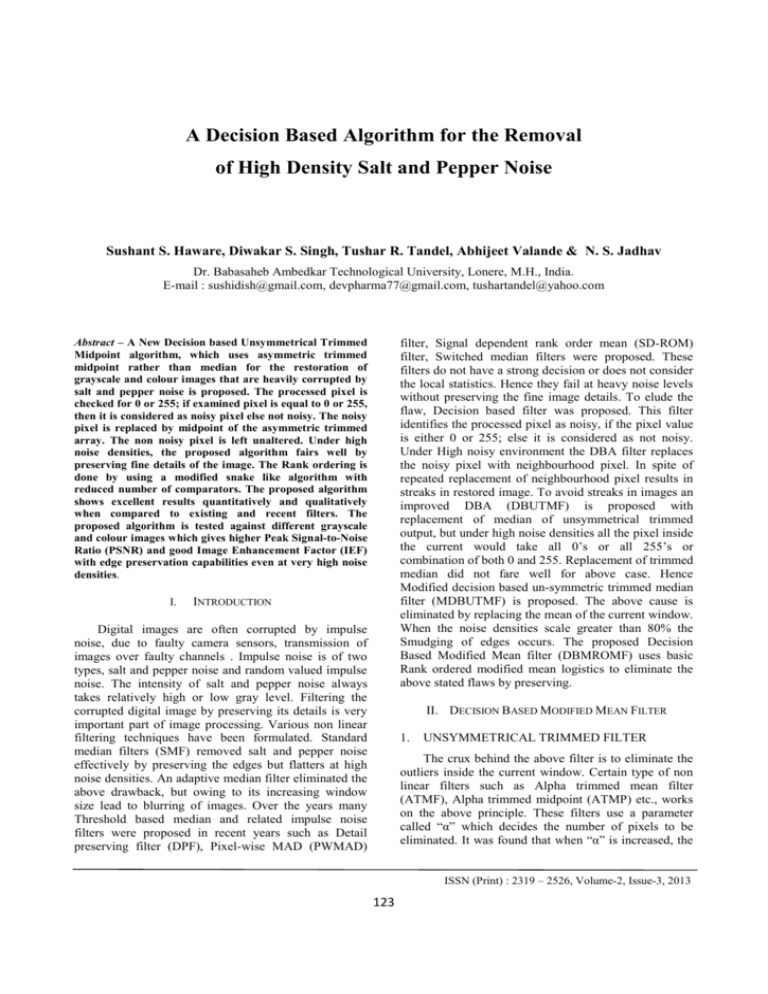
A Decision Based Algorithm for the Removal of High Density Salt and Pepper Noise Sushant S. Haware, Diwakar S. Singh, Tushar R. Tandel, Abhijeet Valande & N. S. Jadhav Dr. Babasaheb Ambedkar Technological University, Lonere, M.H., India. E-mail : sushidish@gmail.com, devpharma77@gmail.com, tushartandel@yahoo.com Abstract – A New Decision based Unsymmetrical Trimmed Midpoint algorithm, which uses asymmetric trimmed midpoint rather than median for the restoration of grayscale and colour images that are heavily corrupted by salt and pepper noise is proposed. The processed pixel is checked for 0 or 255; if examined pixel is equal to 0 or 255, then it is considered as noisy pixel else not noisy. The noisy pixel is replaced by midpoint of the asymmetric trimmed array. The non noisy pixel is left unaltered. Under high noise densities, the proposed algorithm fairs well by preserving fine details of the image. The Rank ordering is done by using a modified snake like algorithm with reduced number of comparators. The proposed algorithm shows excellent results quantitatively and qualitatively when compared to existing and recent filters. The proposed algorithm is tested against different grayscale and colour images which gives higher Peak Signal-to-Noise Ratio (PSNR) and good Image Enhancement Factor (IEF) with edge preservation capabilities even at very high noise densities. I. filter, Signal dependent rank order mean (SD-ROM) filter, Switched median filters were proposed. These filters do not have a strong decision or does not consider the local statistics. Hence they fail at heavy noise levels without preserving the fine image details. To elude the flaw, Decision based filter was proposed. This filter identifies the processed pixel as noisy, if the pixel value is either 0 or 255; else it is considered as not noisy. Under High noisy environment the DBA filter replaces the noisy pixel with neighbourhood pixel. In spite of repeated replacement of neighbourhood pixel results in streaks in restored image. To avoid streaks in images an improved DBA (DBUTMF) is proposed with replacement of median of unsymmetrical trimmed output, but under high noise densities all the pixel inside the current would take all 0’s or all 255’s or combination of both 0 and 255. Replacement of trimmed median did not fare well for above case. Hence Modified decision based un-symmetric trimmed median filter (MDBUTMF) is proposed. The above cause is eliminated by replacing the mean of the current window. When the noise densities scale greater than 80% the Smudging of edges occurs. The proposed Decision Based Modified Mean filter (DBMROMF) uses basic Rank ordered modified mean logistics to eliminate the above stated flaws by preserving. INTRODUCTION Digital images are often corrupted by impulse noise, due to faulty camera sensors, transmission of images over faulty channels . Impulse noise is of two types, salt and pepper noise and random valued impulse noise. The intensity of salt and pepper noise always takes relatively high or low gray level. Filtering the corrupted digital image by preserving its details is very important part of image processing. Various non linear filtering techniques have been formulated. Standard median filters (SMF) removed salt and pepper noise effectively by preserving the edges but flatters at high noise densities. An adaptive median filter eliminated the above drawback, but owing to its increasing window size lead to blurring of images. Over the years many Threshold based median and related impulse noise filters were proposed in recent years such as Detail preserving filter (DPF), Pixel-wise MAD (PWMAD) II. DECISION BASED MODIFIED MEAN FILTER 1. UNSYMMETRICAL TRIMMED FILTER The crux behind the above filter is to eliminate the outliers inside the current window. Certain type of non linear filters such as Alpha trimmed mean filter (ATMF), Alpha trimmed midpoint (ATMP) etc., works on the above principle. These filters use a parameter called “α” which decides the number of pixels to be eliminated. It was found that when “α” is increased, the ISSN (Print) : 2319 – 2526, Volume-2, Issue-3, 2013 123 International Journal on Advanced Computer Theory and Engineering (IJACTE) filter fared well. For high noise densities it does not preserve the image information due to the elimination of outlier values. So to overcome the drawback of fine detail preservation and removal of impulse noise during heavy noise conditions Decision based midpoint (DBMP) is proposed. 2. Step3: Sort the three columns of the 2D array in ascending order .The sorted sequence is fed to step4 as shown in figure 1.c. Step4: Repeat step 2 and 3 once again as shown in figure1.d and e. Step5: Now Sort the upper semi diagonal of the semi sorted 2D array in ascending order as shown in figure1.e. SNAKE LIKE IMPROVED SHEAR SORTING Over the years sorting algorithm is a basic operation behind all the median filters. All the existing sorting algorithms require more comparators as shown in table 1. In this paper a new snake like improved shear sorting algorithm is proposed for ordering the entire array of processed pixels as shown in figure 1. Let D be an m x n matrix which is mapped with linear integer sequence W. Sorting the sequence W is then equivalent to sorting the elements of D in some Pre determined indexing scheme. The proposed Snake like modified algorithm consists of three basic operations row sorting, column sorting and semi diagonal sorting. The algorithm of the proposed snake like improved shear sorting algorithm is as follows. Step6: Sort the Lower semi diagonal sorted array in ascending order as shown in figure1. Resulting array is sorted in a snake like order. The procedure is repeated for the other windows of the image. 3. PROPOSED ALGORITHM (a) For Image Fig. 2: Flowchart for processing an image Sequence by DBUTM The Decision based modified Rank ordered mean filter (DBMROMF) initially detects impulse and corrects it subsequently. All the pixels of an image lie between the dynamic ranges [0,255]. If the processed pixel holds minimum (0) or maximum (255), pixel is considered as noisy and processed by DBMMF else as not noisy and the pixel is unaltered. The brief illustration of the algorithm is as follows. Fig. 1: Illustration of proposed sorting methodology. Step1: The considered 2D processing window as shown in figure 1.a th Step2: Sort the 1 and 3 rd rows of the 2D array in nd ascending order and 2 row in descending order independently .The sorted sequence is fed to step3 as shown in figure1.b. Fig. 3: Flowchart of DBUTM ISSN (Print) : 2319 – 2526, Volume-2, Issue-3, 2013 124 International Journal on Advanced Computer Theory and Engineering (IJACTE) Step 1: Choose 2-D window of size 3x3. The processed pixel in current window is assumed as p . 4. xy Step 2: Check for the condition 0 < p xy Frames to movie: After completing the entire process, the processed frames are finally converted back into original movie. < 255, if the condition is true then pixel is considered as not noisy and left unaltered. Step 3: If the processed pixel p (p =0 or p xy xy xy =255) then pixel p holds 0 or 255 i.e. xy is considered as corrupted pixel. Convert 2D array into 1D array. Sort the 1D array which is assumed as S . xy Step 4: Initialize two counters, forward counter (F) and reverse counter (L) with 1 and 9 respectively. When a 0 or 255 are encountered inside the window F is increased by 1 or L is decremented by 1 respectively. When pixel is noisy there happens to be two possible cases. Fig. 4: Flowchart for processing a Video Sequence by DBUTM 4. Case I: If the processing pixel is noisy and the current s INSIGHT OF METHODOLOGY THE PROPOSED The salt and pepper noise is initially detected by comparing the processed pixel with 0 or 255. This process is done on entire pixels in the image. The bigger matrix refers to image and values enclosed inside a rectangle is considered to be the current processing window. The element encircled refers to processed pixel. Step 2 is illustrated in Case (1). Step 3 and 4 are visualized along with the case I in Case (2) .Case II is briefed in case (3). s. Processed window contains few 0’ and 255’ So check for 0 or 255 in sorted array S , simultaneously counters xy would propagate along the S array thereby eliminating xy outliers retaining only the pixel that hold values other than 0 and 255. After checking all the pixels F and L would hold a particular value indicating the number of outliers eliminated on either sides. The noisy pixel is replaced by the midpoint of the sorted array. Case (1): In the illustration given below, check the processed pixel for 0 < pxy < 255. In this case the processed pixel is 106. Hence processed pixel is not 0 or 255. So pixel is considered as noise free and pixel is unaltered. Case II: If every pixels that reside inside the kernel is the combination of 0 or 255. Even this condition is addressed by the case I operation. There by making the algorithm simple. When all the pixel elements hold 0 or 255 then the values are retained, assuming it as texture of the image. Step 5: Steps 1 to 4 is repeated until all pixels of the entire image is processed. (b) For Video Processing Corrupted image segment The video sequence is first converted into frames and frames into images. Then DBUTM algorithm is applied to the images which are separated from frames. After the filtering process, the frames are converted back to the original movie. 1. Video to frames: The noisy video sequence containing Impulse noise is converted into avi format, which is an Uncompressed format and frames are extracted from the Video. 2. Frames to images: Frames are then converted to images for further processing. 3. Filtering method: The noisy images are de noised using DBUTM algorithm. Restored image segment Case (2): In the selected window the processed pixel holds 0 (or 255). So the processed pixel is considered as noisy. Initialize forward counter F=1 and reverse counter L=9. Convert the 2D array into 1D array and sort the converted array. F and L counter moves in forward and reverse directions respectively. Corrupted image segment Restored image segment ISSN (Print) : 2319 – 2526, Volume-2, Issue-3, 2013 125 International Journal on Advanced Computer Theory and Engineering (IJACTE) Unsorted array: 94 0 0 0 0 122 255 127 255 Where r refers to Original image, n gives the corrupted image x is denotes restored image, M x N is the size of Processed image. Sorted array Sxy 0 0 0 0 94 122 127 255 255 Now check for the presence of 0 or 255 in the sorted array. Every time a 0 is detected F is incremented by1 and 255 is detected L is decremented by1. In the above example there are three 0 and two 255. Hence F is incremented by four times and L is decremented by 2 times. Now finally F is holding 5 and L is holding 7. Now the corrupted pixel is replaced with midpoint of the trimmed array i.e. corrupted pixel is replaced by (S(4)+S(7))/2 = (94 +127)/2= 110. The existing algorithms used for the comparison are SMF, AMF, DBA, DBUTMF. The qualitative performance of the proposed algorithm is tested on various images of various compositions. Quantitative analysis is made by varying noise densities in steps of ten from 10% to 90% on low detail, medium detail and high detail images and comparisons are made in terms of PSNR, IEF, MSE and Time results are given in Table I, and figure 6,7 respectively. It is vivid from the tables and figures that the proposed algorithm fairs on par with DBUTMF at low noise densities. In case of high noise densities the proposed algorithm has excellent noise suppression characteristics. Hence the algorithm has high PSNR, IEF and low MSE when compared to other algorithms. Case (3): This sub case works if the entire pixel inside the current window is either pepper (0) or salt (255). Initialize F=1 and L=9 and convert the elements of 2D window into 1D. Sort the 1D array. Corrupted image segment Restored image segment Unsorted 1D array: 0 255 0 0 0 255 255 255 255 Fig. 5: (a) original image (b) 30% noise corrupted image. Restoration results of (c) SMF (d) AMF (e) DBA (f) DBUTM Sorted 1D array Sxy: 0 0 0 0 255 255 255 255 255 Now the F counters propagates forward and L in reverse direction. Finally F and L hold 5 and 4 respectively. Hence the noisy pixel is replaced by (S (5) + S(4))/2= (255+0)/2=122. III. SIMULATION RESULTS & DISCUSSIONS Table I: Quantitative results of various filters for 30% corrupted Barbara image The Quantitative performance of the proposed algorithm is evaluated based on Peak signal to noise ratio (PSNR) ,Mean Square Error (MSE) and Image Enhancement Factor (IEF) which is given in equations 1,2,3 respectively. Fig. 6: Performance comparison of PSNR at various noise densities for low detail Lena image ISSN (Print) : 2319 – 2526, Volume-2, Issue-3, 2013 126 International Journal on Advanced Computer Theory and Engineering (IJACTE) V. REFERENCES Fig. 7: Performance comparison of IEF at various noise densities for low detail Lena image IV. CONCLUSION A Decision based algorithm which uses 2D mesh sorting which is simple in approach and used mainly for rank ordering. The proposed algorithm gives excellent noise suppression capabilities in gray scale and colour image corrupted by high density salt and pepper noise. The proposed algorithm also fairs well in preserving the global edge of the high detail image. The proposed algorithm outclasses other classical and existing recent algorithms both quantitatively and qualitatively for very high noise densities. The architecture of the proposed algorithm can also be easily realised. [1] J. Astola and P. Kuosmaneen, Fundamentals of non linear Digital Filtering. Boca Raton, FL: CRC, 1997.. [2] H. Hwang and R. A.Hadded, “Adaptive median filter: New algorithms and results,” IEEE transaction on image processing., vol 4,no 4,pp 499-502. [3] Naif Alajlan, Mohamed Kamel, Ed Jernigan, “Detail Preserving impulse noise removal”, International journal on Signal processing: image communication, pages 993-1003, Vol 19, 2004. [4] K.S. Srinivasan and D.Ebenezer, “A new fast and efficient decision based algorithm for the removal of high density impulse noise,” IEEE Signal processing letters, vol.14, no.3, pp.189-192, March 2007. ISSN (Print) : 2319 – 2526, Volume-2, Issue-3, 2013 127
